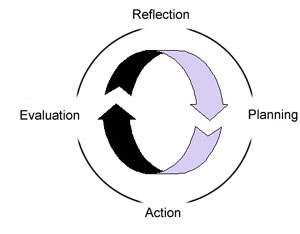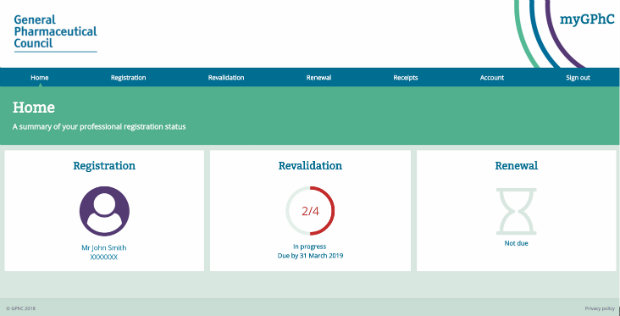Hi and welcome to PharmacyCPA's (PCPA) new tutorial on Continuing Professional Development (CPD) and GPhC revalidation. Firstly, we will give you a brief overview of what CPD and revalidation are, followed by a step by step walkthrough of the official GPhC CPD learning site www.mygphc.org.

What is revalidation?
Revalidation is the annual process by which pharmacists and technicians submit their CPD records to the GPhC. CPD records were previously (pre-2018) submitted onto the GPhC's website. This involved compiling entries under the following subsections (also as seen above):
- Reflection
- Planning
- Action
- Evaluation
This has been superseded by the new recording format for GPhC revalidation, with different entry fields depending on whether you are completing learning as either a planned/unplanned CPD entry, a peer discussion record or a reflective account record. Four CPD entries (two of which must be planned) must be submitted at least two months before your GPhC renewal date and also must contain a peer discussion and reflective account entry. The GPhC is bound by Data Protection laws and therefore it must delete your submitted records every two years, it is therefore highly recommended that you use an external CPD recording mechanism such as the free HubNet.io Revalidation Tool.
What is peer discussion?
The peer discussion is a development activity introduced as part of revalidation to encourage pharmacy professionals to reflect upon their practice with someone who understands their work, with the aims of gaining another perspective and reducing professional isolation.
The GPhC has advised that for a peer discussion to be effective it should be "open, honest and with someone who you trust and respect”. Peer discussions can take place in any live format; for example, face-to-face, over the phone, via webchat, a video call or any other means of real-time communication.
What are reflective accounts?
The reflective account should describe how you have met one or more of the GPhC's standards - the exact standards will be determined by the regulator on a yearly basis - with examples given of how this has affected "service users” (eg patients/public). All registrants for a given year will be given the same standard(s).
The GPhC has said that your reflective account must include:
- a brief summary of your practice history for the previous year, including who the typical users of your service may be (for example, patients in your community pharmacy)
- a statement of how you have met one or more of the GPhC's standards for pharmacy professionals (as set annually)
- real-life examples to support your statement.
Okay, but do I have to do it?
Yes, even if you do not work in a patient care role it is essential that you use CPD. Not only is it now mandatory but it is highly useful if something goes wrong. For example, imagine if in your course of duty you accidentally caused an error that leads to a criminal investigation. The investigators are more likely to look at you in a more favourable light if you were seen to be keeping up to date with your clinical knowledge. There is no better way to officially prove you are competent than using CPD. In the words of the GPhC:"If a complaint is made against you the GPhC's fitness to practise committees will take account of the requirements of the Code of Ethics and underpinning documents, including this one. You will be expected to justify any decision to act outside its terms.”
But I only work part-time...
The CPD requirements apply equally to all practitioners. They are not changed by factors such as part-time employment or working in positions of authority. You are expected to cover the full scope of your practice in your CPD record, including responsibilities such as superintendent or pharmacist prescriber and roles in different settings such as industry and community pharmacy.Are there any mandatory requirements?
There are two main CPD standards that the GPhC requires you to abide by:1) Legibility - it used to be a fact that you could submit your entries on paper to the GPhC, however, this is now not possible. CPD records must be easily accessible and readily submittable to mygphc.org. They must be written in good English and must not disclose any sensitive patient information.
2) A minimum of four CPD entries per year, 2 of which must be classed a "Planned" - these must reflect the context and scope of your practice.
Furthermore, there are some Good Practice suggestions these include:
- You should maintain a learning portfolio with records of attendance and key learning points from continuing education and notes of other learning e.g. through work. This will provide a useful resource for reference. (The learning portfolio is a personal record of professional development that can provide evidence for your CPD record).
- You are likely to learn more than you need to meet the GPhC's CPD requirement through working as a pharmacist or pharmacy technician. You should aim to complete more than the minimum number of CPD entries each year and reflect on your practice at least once per month.
- You should make some CPD entries that start at the reflection stage.
- You should ensure that your CPD record is up to date.
- You should take part in and record CPD that results from a range of learning activities that are relevant to your practice as a pharmacist or pharmacy technician and is, overall, relevant to pharmacy.
Walkthrough
Introduction
The basics of this are: Find something wrong with your practice-this could be a gap in your knowledge, error in practice etc. You then assess and document this and then plan how you will remedy the problem area. You then formulate a solution and implement it. You then monitor this implementation and see if anything goes wrong. If the problem is solved then you find another problem. If the problem continues then you repeat the cycle. Simple!
Getting started
Open up your internet browser - it does not matter which one, the site is quite stable - and go to www.mygphc.org
At the top left of the page, there is a login button, click this and you will be asked for certain parameters.
These are very specific and must be obtained from the GPhC. At the moment they cannot be sent via email and must be sent via post, this usually takes a couple of days.
If you have already got a username and password but have forgotten you can enter your details and then click "resend via post”.
The first page gives you a variety of options the most important of which are outlined below...

To proceed directly to entering your mandatory CPD records click the first option "CPD record”.
The other sections include:
- Guide to using this site - this is a very useful help guide to www.mygphc.org, we highly recommend reading this through when first logging in.
- Change Password
- Change Username
- Review and Feedback - the website is relatively new and any bugs or errors which you find please report them here.
- Log Out - every time this website system is used it is very important to log out after each use. If you have cookies enabled on your computer the system may keep you logged in. In this case, someone could access and possibly alter your records. Be warned and log out!
The main page, which is tabbed with two separate boxes to the left. The top box is named Folders and the bottom, Entries. Firstly, create a file that can categorise your entries. In this case, we have created one called "repeat dispensing”, this file will contain all CPD records that have been related to repeat dispensing.
To make an entry in any specific folder click the folder then in the entries box click "New”...
On the right, there will be a page tabbed with the 4 stages of the cyclical CPD cycle. It should be used exactly as the cycle is used. Once one stage is complete, move to the next, once you get to the last, go back to the beginning.
Being a good pharmacist nowadays means you have to be highly dynamic. The information requirements change almost daily and as pharmacists, we have a mandatory duty to stay on top of it all. Overall, the MyGPhC system provides an accessible, easy to use program which used in combination with other resources can prove to be invaluable.
The most useful of these other sources include:
If you have any further queries as to CPD or the site, please contact us via our email link on www.pharmacycpa.com.
